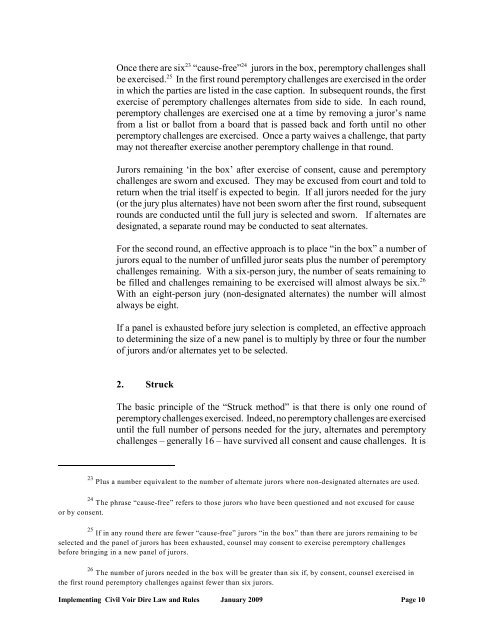IMPLEMENTING NEW YORK'S CIVIL VOIR DIRE LAW AND RULES
IMPLEMENTING NEW YORK'S CIVIL VOIR DIRE LAW AND RULES
IMPLEMENTING NEW YORK'S CIVIL VOIR DIRE LAW AND RULES
Create successful ePaper yourself
Turn your PDF publications into a flip-book with our unique Google optimized e-Paper software.
23 24<br />
Once there are six “cause-free” jurors in the box, peremptory challenges shall<br />
25<br />
be exercised. In the first round peremptory challenges are exercised in the order<br />
in which the parties are listed in the case caption. In subsequent rounds, the first<br />
exercise of peremptory challenges alternates from side to side. In each round,<br />
peremptory challenges are exercised one at a time by removing a juror’s name<br />
from a list or ballot from a board that is passed back and forth until no other<br />
peremptory challenges are exercised. Once a party waives a challenge, that party<br />
may not thereafter exercise another peremptory challenge in that round.<br />
Jurors remaining ‘in the box’ after exercise of consent, cause and peremptory<br />
challenges are sworn and excused. They may be excused from court and told to<br />
return when the trial itself is expected to begin. If all jurors needed for the jury<br />
(or the jury plus alternates) have not been sworn after the first round, subsequent<br />
rounds are conducted until the full jury is selected and sworn. If alternates are<br />
designated, a separate round may be conducted to seat alternates.<br />
For the second round, an effective approach is to place “in the box” a number of<br />
jurors equal to the number of unfilled juror seats plus the number of peremptory<br />
challenges remaining. With a six-person jury, the number of seats remaining to<br />
be filled and challenges remaining to be exercised will almost always be six. 26<br />
With an eight-person jury (non-designated alternates) the number will almost<br />
always be eight.<br />
If a panel is exhausted before jury selection is completed, an effective approach<br />
to determining the size of a new panel is to multiply by three or four the number<br />
of jurors and/or alternates yet to be selected.<br />
2. Struck<br />
The basic principle of the “Struck method” is that there is only one round of<br />
peremptory challenges exercised. Indeed, no peremptory challenges are exercised<br />
until the full number of persons needed for the jury, alternates and peremptory<br />
challenges – generally 16 – have survived all consent and cause challenges. It is<br />
23<br />
Plus a number equivalent to the number of alternate jurors where non-designated alternates are used.<br />
24<br />
The phrase “cause-free” refers to those jurors who have been questioned and not excused for cause<br />
or by consent.<br />
25<br />
If in any round there are fewer “cause-free” jurors “in the box” than there are jurors remaining to be<br />
selected and the panel of jurors has been exhausted, counsel may consent to exercise peremptory challenges<br />
before bringing in a new panel of jurors.<br />
26<br />
The number of jurors needed in the box will be greater than six if, by consent, counsel exercised in<br />
the first round peremptory challenges against fewer than six jurors.<br />
Implementing Civil Voir Dire Law and Rules January 2009 Page 10

















